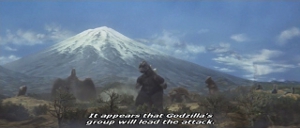
For G-fans, this is the Big One, the culmination of all that came before. It’s easy to see why since Kaijû sôshingeki (“Charge” or “Invasion” or “Attack of the Monsters“; take your pick) hits the ground running with none of the drawn-out build-up we’ve come to expect from these flicks…especially those directed by Ishiro Honda. By the eleven minute-mark, Godzilla’s nuking the UN and his monstrous colleagues are reducing other major cities to scrap. By the end of the film, ten monsters engage the twice-defeated (yet inexplicably popular) King Ghidorah in a no-holds-barred brawl in the shadow of Mt. Fuji, which became legendary before the film’s premiere.
So the number one reason cited for out-and-out loving Destroy All Monsters is totally valid. Here, you really can get more monsters for your money and the scope of that Climactic Battle is mind-bending, both as a piece of cinema and as a technical landmark in film making history. Ten monsters, most of them actors in costumes, the rest puppets, all requiring some manner of off-screen puppeteers to keep up the illusion. It was a logistical nightmare of actors and wires and animatronics, all under hot lights, sixteen hours a day…but thanks to the magic of editing and shot composition, its made not only beautiful, but enduringly awesome.
For many G-fans, that fight alone ensures this film can do no wrong. For others, Destroy All Monsters can do no wrong because it was their introduction to Godzilla and his universe. A certain generation (the one right ahead of mine, in fact) grew up seeing this film on network TV, where it played with varying degrees of regularity until the 1980s. This was back in the days when there were only three networks and they bought up catalogs of cheap, old films to shore up their schedules.
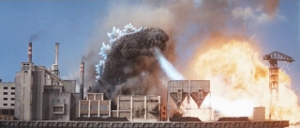
Unfortunately, I came of age in a time long after Destroy All Monsters effectively vanished from North America. Every other Godzilla film, from the Raymond Burr-ified Terry O. Moss cut of the original to the series’ then-latest entry, whatever it was, enjoyed some kind of U.S. re-release during the VHS era…except this one. It became a ghost and like most Ghosts That Walk its legend only grew with its continued absence. It became a movie that could never live up to the image in my head, or the image in the heads of a my generation.
So, when I finally saw it in the late 90s (on the then-new Sci-Fi Channel), rather than admit my own disappointment or challenge myself to articulate why I felt so disappointed, I shrugged and regurgitated the ten-plus years of opinion I’d received. That was so much easier than writing a genuine review, you guys. Seriously. Look how awkwardly this one is turning out. You think I want to do this? I don’t have a choice! It is my moral duty, as a critic and a human being, to come before you and explain why Destroy All Monsters isn’t a very good movie.
First, let me clear the air. The movie’s problems have nothing to do with it’s obviously-dated nature. Yes, it begins in the far-flung year of 1999! Yes, the United Nations Science Committee of this universe has long-since established a “rocket base” on the moon, with daily connecting flights from their “rocket base” on Earth and a full compliment of scientists up there, dong…science-y things. None of which is “silly,” nor particularly “outlandish,” especially for 1968. What it is is fucking awesome. It’s everything I love about mid-century sci-fi: the boundless optimism of a future where technology can solve everything. I love the boundless naivete of the generation behind the cameras, who believed no new problems would arise save from Outside ourselves. All good, thematic stuff you can parse out into a million sub-conversations about how the past viewed tomorrow. And why the number one vision of our future involves a zombie apocalypse.

But just as you turn to your date, ready to start a little somethin’, the movie ruins the mood by committing one of cinema’s cardinal sins and dumping five minutes of exposition into our ears via Humble Narrator. Not only has the humanity of this 1999 colonized the moon, they’ve captured and confined all of Earth’s monsters (even ones that died at the end of their own movies) to the small, South Pacific island of Ogasawara…somehow. Whatever canonical or fanonical justification’s been retroactively arrived at in the meantime, fact is, no explanation’s offered in this film. Now renamed “Monster Island” (or “Monsterland” depending on which copy you’re watching) force fields and gas emitters keep its charges confined, the better for scientists study them from an underground bunker. Humanity has triumphed and bound all the techno-organic devils it awakened in the Atomic Age. Looks like smooth sailing into the stars for the human race. Obviously, something must go wrong.
That something is the second conquest-minded alien race in Godzilla’s series and the fourth in Toho’s tokusatsu films overall, not counting the Mu who were human, albeit from a continent that sank beneath the sea. Like the Xians, the Kilaaks hail from one of those tiny planets somewhere around Jupiter. Naturally, it’s cold out there, so they hope to make nice, warm, safe Earth their new home. Knowing how xenophobic and paranoid humans generally are they cut to the chase. No overtures of friendship or desperate pleas for help this time: it’s knockout gas and the brainwashing all around. Humans are reduced to worker bees and the monsters sent out to attack Earth’s capital cities (and New York, which was our capital for a few years early in the republic’s life, and hasn’t gotten over its replacement for the last two centuries, so that’s fair). Newly arrived research assistant Kyoko (Yukiko Kobayashi) is caught in the Kilaak assault, right in the middle of a video chat with her astronaut boyfriend Katsuo (Akira Kubo, in his third, and last, Godzilla movie) who’s on the frickkin’ moon! God, I love writing things like that and meaning them literally. How many movies casually take place on the frickkin moon anymore? That can’t be a good thing.
Despite his proximity, Science Command orders Katsuo and his rocketship, Moonlight SY-3, to go check out Monster Island. You might ask yourself: why send Akira Kubo instead of…oh, say…some marines? Or mercenaries? Or cyber-ninjas? Or giant robots piloted by teenagers with personality issues? The only answer can be, “Because he’s Akira Kubo and at this point, he’s still a heartthrob.” As mid-60s Japanese heartthrobs go, I’ve never understood his appeal…but I’m sure a lot of people are just as mystified by my eternal love for Beverly Maeda. Especially if she’s wearing khaki pants.
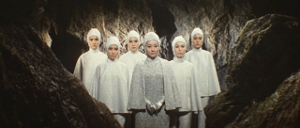
Either way, Dr. Yoshida (Jun Tazaki) of the UNSC orders Kubo to Monster Island so they (and we) can learn the plot. A plot everyone in the audience already knows, if not through sheer osmosis, than because they’ve seen Godzilla vs. Monster Zero/Invasion of the Astro-Monster/Whatever else you want to call it. Both stories devolve into a race to break the alien’s hold over Earth’s monsters and Earth’s people. In both cases, Kubo’s character discovers the alien’s One Weakness (low temperatures this time, as opposed to sound) forcing them, in a last desperate move, to pull King Ghidorah out of retirement for the third time and force the climax.
So the plot is a stale retread of an only-three-years-old-at-the-time story with the same decent actor in a worse role. I find Kubo much more engaging as a Snarky Everyman or Nebbish Inventor than Intrepid Astronaut. Katsuo’s a pulp novel protagonist: eternally optimistic, always right about everything. He’s everything Superman’s accused of being. Too damn good to be anything other than boring, no matter how many alien bases he and his men blow up, or how many flying saucers Moonlight SY-3 shoots down. Everyone goes on and on about the monster action, and while it does kick mucho ass, it’s embedded in a human story that’s equal parts boring and predictable.
At least Honda’s back in the Big Chair, so while his direction is less kinetic than Jun Fukuda’s, it makes up for it with more interesting compositions:

and some sweet gams:
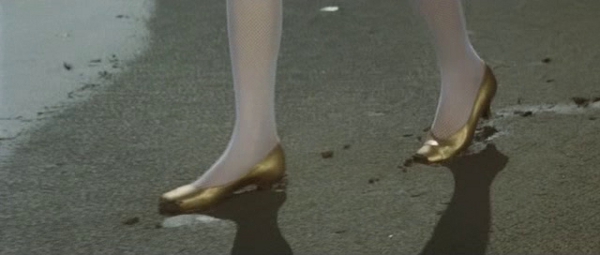
which help keep the mind awake through all the scenes of Akira Kubo and Jun Tazaki jawing over the problem. As do the gunfights, which go from a rarity in the sub-genre to an out-and-proud staple of it in one jump. (This one.) All the actors perform well, as only old hands can when they’re working for a director they’ve worked with steadily for twenty years.
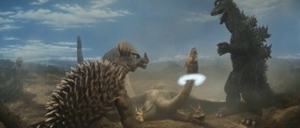
Better still, new special effects director Sadamasa Arikawa rises to the challenge of filling Tsuburaya’s shoes (the main man having gone into semi-retirement at this point, two years away from his sad death). The terrabytes of praise heaped upon DAM‘s monster scenes are a testament to Tsuburaya’s good hiring policies. There’s no break in visual continuity here: these scenes of civic destruction could be straight out of the early-60s. The climactic battle earns its props but, for me, the highlight of the movie comes when Godzilla, Rodan, Mothra and Manda (the sunken civilization of Mu’s dead god from Atragon) stage a four-way attack on Tokyo halfway through the movie. The Kilaaks saved for last because their base is under Mt. Fuji (of course) and because they’re jerks.
I know no one cares about the thin human story, the boring stock characters, or the baseless “logic” behind the Kilaaks’ invasion plans. But someone has to. Destroy All Monsters is too influential to remain uncritically examined. Which is funny, considering how many notes it cribs from Monster Zero. All the misplaced nostalgia, time-wasting “homages,” and the gigantic clusterfuck that is Final Wars could really all be Monster Zero‘s fault.
But I love Monster Zero and can’t, in good conscience, blame it for all that. If you somehow escaped childhood without seeing Godzilla vs. Monster Zero, you should. It modified the Godzilla Formula for a new generation raised on sci-fi TV shows, where alien invasion plots became an entire industry’s default story. It only became more prevalent after the success of 1966’s Ultraman (the first Japanese TV show popular enough to become a worldwide export, thanks in large part to the special effects of Tsuburaya Studios). At the same time, the Japanese movie industry was bleeding cash at a rate that would give the MPAA seizures. With no internet around to blame, studio heads blamed the rise of TV and thought they saw the writing on the wall. Within a generation, no one would watch movies. At least half the theaters in Japan would close over the course of the 70s, even as the Godzilla series continued to flourish in a diminishing-returns sorta way every patron of long-running Hollywood movie series should recognize.

That’s the true irony of Destroy All Monsters: it was meant to be a swan song, both for Godzilla and for the giant monster movies he spawned. Japanese movie studios of the time were abandoning elaborate, expensive, SF and period piece productions in favor of contemporary gangster flicks (yakuza eiga – hence the increasing emphasis on gunfights as the Godzilla series continued) and pre-porno, sexpoloitative “pink films” (Pinku eiga), either of which could be made cheaply and (often) in under a week. The WWII veterans who began Japanese cinema’s Golden Age back in the ’50s were either retiring, dying, or becoming disillusioned with the rising generation and its freakish (to them) taste in movies. Destroy All Monsters was Ishiro Honda’s grand farewell.
But, because the universe has a sick sense of humor, it became one of the most financially successful Godzilla film of all time, saving both its main “mon-star” and its genre from a premature death. Because they meant it as a farewell, Toho authorized a higher budget that translated into more spectacle, however empty it might be. And spectacle, as many a movie studio would spend the 70s learning well, can overpower even the most mediocre script. So while I can’t love Destroy All Monsters as much as some, I can’t hate it either, even in jest. It kept the flame alive, and carried the genre forward. Without it, we wouldn’t have some of my favorite examples of the sub-genre.
It’s a chocolate explosion of man-in-suit monster and model-on-wire spaceship action wrapped in 100% recycled material, required viewing for all monster fans of every age and point in life…though I’d recommend at least five our films over it. Films with better characters in stronger plotlines that might actually move you to care. Still, I love the lavishness on display here, the sheer brazen balls of it all, even as I criticize the corners that were obviously cut to make room for them. Hell, I can do both at the same time and I hope I’ve done that here. After all, if you submit to the will of Godzilla, anything is possible.
![]()
![]()
![]()
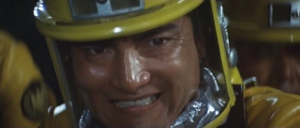

I saw this when I was 4. It was the best movie of all time.
Cut to 14 years later. I FINALLY get to see it again, on a bootleg video tape. I’m stunned. Where is the amazing movie I remembered? What is this overly long, dull film with boring human characters doing boring human things and occasionally interrupted by monster bashes?
I’ve never gotten over the disappointment. Not when I saw better copies of it, not when I saw it in the original Japanese with subtitles. I don’t think I ever will.
Yeah, that pretty much sums it up right there, save for the bootleg tape and the timeline’s a little compressed. I’m pretty sure the version I saw was the old American International/Titra dub, which has gone from being despised to being a nostalgic touchstone now that we can compare it to the international version.
Me, I’m continually amazed by how well Monster Zero continues to hold up on so many levels, and how this feels like an inferior xerox with some shinny new stickers attached to it, as if that would disguise the plagiarism. It’s another sad example of what happens when producers try to Give The People What They (supposedly) Want. And it’s far from the last time our Big G’s suffered for that.
Zero holds up for me only because it’s far better unintentional comedy, but, yeah, this movie is a blatant copy of it, and most definitely suffering from the “MORE! THE FANS WANT MORE!” problems.
Worse – they need more. Or, more accurately, “We – the filmmakers – need them to need More because More is the only thing that will possibly lure them away from the TVs. I mean, sure…we could do less and just make what we do better…but that sounds complicated. Why bother when we could just give them More?”
David, I actually experienced a virtually identical situation. As a kid, I wanted to see Destroy All Monsters with a vengeance. My friends talked about how often it was on cable (we didn’t have cable) and I found a book on Godzilla movies in the school library that called it the best of the Godzilla films and showed some tantalizing b&w screen shots. I begged my mother to buy every G film that I could find in the vhs displays that Hills or Kmart had. With hours spent looking, I could never find it and only found Godzilla vs the Smog Monster once (which sadly didn’t follow me home). Then, many years later, my Godzilla interest started kicking back in (Thirty seems to be the magic age when nostalgia begins) and I managed to snag one of the Media Blaster dvds. I was thrilled to get it too, because those suckers disappeared overnight. I finally got to watch a film that I had been waiting for nearly 20 years! I suppose that nothing could have lived up to that. Just the same, DAM was a huge disappointment. Ghidra’s fight against the other monsters seemed less like a tense battle and more like a massacre. The movie was boring and for some reason Godzilla’s radiation breath curved. The curving breath annoyed me.
It’s extremely heartening to know this resonates beyond the superficial level. I made the mistake of grabbing the ADV release when it first came out, overjoyed at my what I considered at the time to be “luck” Growing up in a strictly Wal-Mart region, I could have bought five different copies of the original Godzilla vs. Mechagodzilla (I restricted myself to just two) but this, anything more modern, and substantial chunks of the Showa series (the good ones) were MIA until late into the 90s, and I had no reliable access to the DVD revolution until I moved to a decent city.
Safe to say pretty much the entire film annoyed me, the way wasted potential always does. Sacrilegious as it may sound, I actually prefer to Animated Series’ take on the whole concept to this, or the Too Hip For the Room Power Rangers/X-Men mash-up that was Final Wars. Which we can actually discuss now that this is out of the way.
It’s such a horrific massacre. Ghidra just shows up to get beat down.